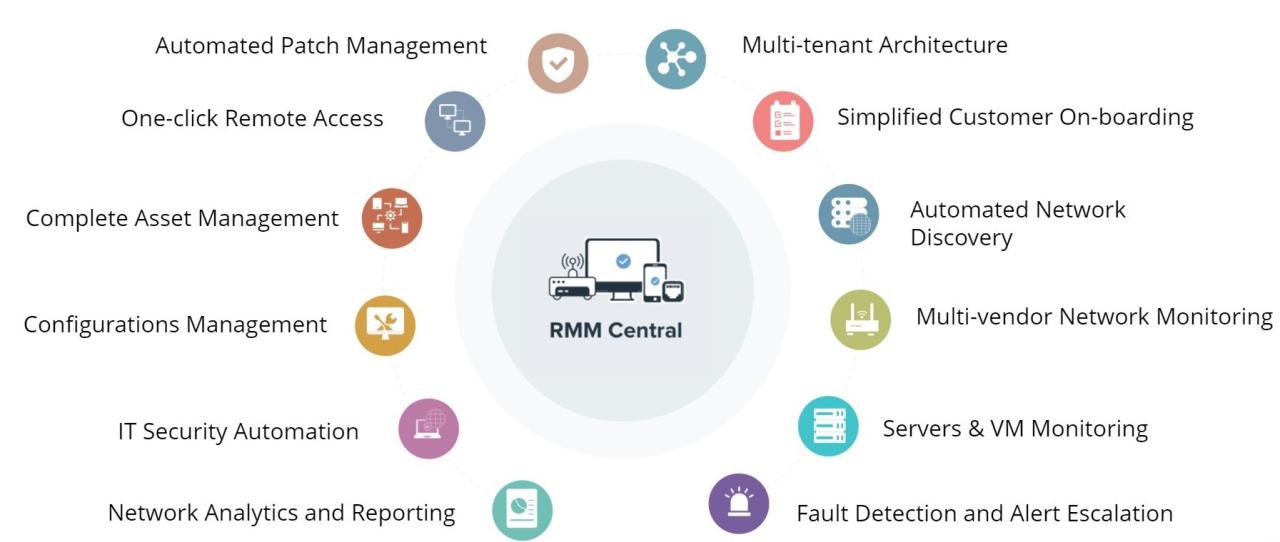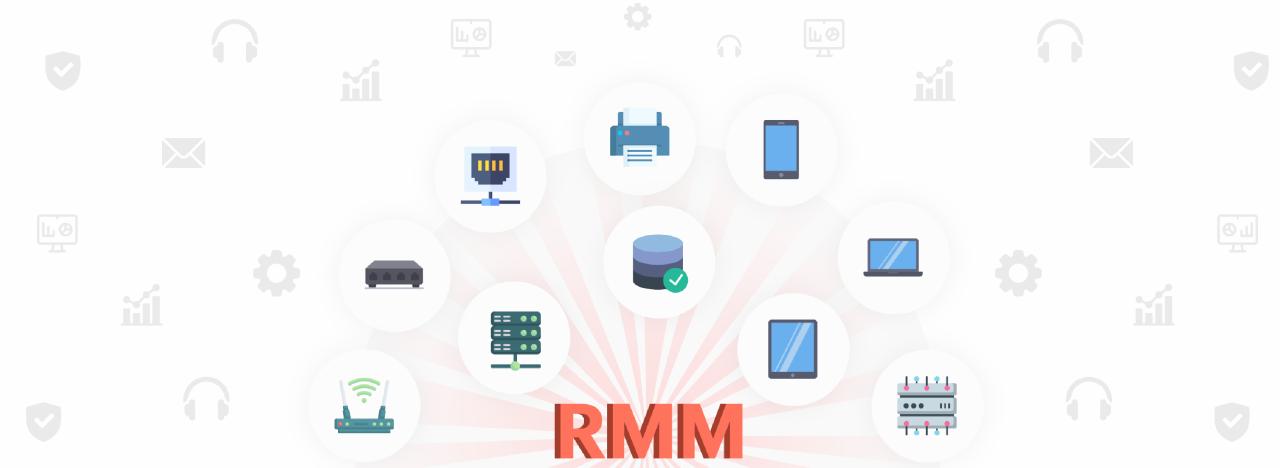RMM features are the backbone of modern IT management, empowering businesses to remotely monitor, manage, and secure their systems with unparalleled efficiency. These features provide a comprehensive suite of tools to address diverse IT needs, from endpoint management and security to patch deployment and automated reporting.
Table of Contents
By leveraging RMM solutions, organizations can proactively address potential issues, optimize system performance, and enhance overall IT security posture. This approach not only streamlines daily operations but also empowers IT teams to focus on strategic initiatives and innovation.
Endpoint Management: Rmm Features
Endpoint management is a critical aspect of IT infrastructure management, and RMM tools play a significant role in streamlining this process. By providing a centralized platform for managing endpoints, RMM solutions empower IT teams to efficiently manage, monitor, and secure devices across the entire network.
Remote Control
Remote control capabilities are a cornerstone of RMM solutions, enabling IT administrators to connect to and manage endpoints remotely. This functionality is invaluable for troubleshooting issues, installing software, or performing other administrative tasks without physically accessing the device.
- Immediate Problem Resolution: Remote control allows IT teams to quickly address issues, such as software glitches or connectivity problems, without the need for on-site visits. This reduces downtime and improves user productivity.
- Simplified Software Deployment: RMM tools facilitate the deployment of software updates and applications remotely, eliminating the need for manual installation on each individual device. This ensures that all endpoints are up-to-date with the latest security patches and software versions.
- Enhanced Security: Remote control allows IT teams to monitor and manage security settings on endpoints, ensuring that devices are protected against malware and other threats. They can remotely implement security policies, install antivirus software, and monitor system activity for suspicious behavior.
Software Deployment
RMM tools automate the process of software deployment, ensuring that all endpoints receive the necessary updates and applications. This streamlined approach simplifies the management of software updates, reduces the risk of manual errors, and ensures that all devices are running the latest versions of software.
- Automated Updates: RMM solutions automate the delivery of software updates, ensuring that all endpoints are kept up-to-date with the latest security patches and bug fixes. This reduces the risk of security vulnerabilities and improves system stability.
- Targeted Deployment: RMM tools allow for targeted software deployment, enabling IT teams to deploy specific applications to specific groups of users or devices based on their roles or requirements. This ensures that users only receive the software they need, improving efficiency and reducing clutter.
- Simplified Patch Management: RMM solutions simplify patch management by automating the process of identifying, downloading, and installing updates for all software installed on endpoints. This reduces the risk of security vulnerabilities and ensures that all devices are running the latest versions of software.
Inventory Management, Rmm features
RMM tools provide a centralized inventory of all endpoints, enabling IT teams to track hardware and software assets across the network. This comprehensive view of the IT infrastructure facilitates efficient management, optimization, and troubleshooting.
- Hardware and Software Tracking: RMM tools provide a comprehensive inventory of all hardware and software assets, including operating systems, applications, and hardware specifications. This information is essential for planning, budgeting, and ensuring compliance.
- License Management: RMM solutions can help track software licenses, ensuring that organizations are compliant with licensing agreements and avoiding potential legal issues.
- Asset Optimization: RMM tools provide insights into asset utilization, enabling IT teams to identify underutilized resources and optimize the allocation of hardware and software. This can help reduce costs and improve overall efficiency.
Reporting & Analytics

Reporting plays a crucial role in RMM by providing valuable insights into the health and performance of managed systems. RMM solutions go beyond basic monitoring, offering detailed reports that can help IT professionals identify trends, proactively address potential issues, and make data-driven decisions.
Insights into System Performance and Security
RMM solutions provide a comprehensive view of system performance and security by collecting and analyzing data from various sources. These insights are essential for identifying potential issues, optimizing resource utilization, and ensuring the overall health of the IT infrastructure.
- System Performance Monitoring: RMM tools monitor key performance indicators (KPIs) such as CPU usage, memory consumption, disk space utilization, and network bandwidth. This data allows IT professionals to identify performance bottlenecks, resource allocation issues, and potential hardware failures.
- Security Posture Assessment: RMM solutions regularly scan systems for vulnerabilities, malware, and other security threats. They provide reports on the security posture of managed systems, identifying potential risks and recommending appropriate mitigation measures.
- Patch Management Effectiveness: RMM tools track the status of software updates and patches, ensuring that systems are kept up-to-date with the latest security fixes. Reports on patch management effectiveness help identify systems that are lagging behind in updates and require attention.
Sample Report
A typical RMM report can showcase various metrics, providing a comprehensive overview of the IT infrastructure’s health and security. The following table presents a sample report with key metrics monitored by an RMM tool:
| Metric | Description | Value | Status |
|---|---|---|---|
| CPU Utilization | Average CPU usage across all managed systems | 25% | Healthy |
| Memory Consumption | Average memory usage across all managed systems | 60% | Warning |
| Disk Space Utilization | Average disk space utilization across all managed systems | 80% | Critical |
| Network Bandwidth Usage | Average network bandwidth usage across all managed systems | 50% | Healthy |
| Vulnerability Count | Number of identified vulnerabilities across all managed systems | 10 | High |
| Patch Compliance | Percentage of systems with all critical patches applied | 95% | Good |
RMM for Different Business Sizes

Remote monitoring and management (RMM) solutions are designed to help businesses of all sizes manage their IT infrastructure more efficiently and effectively. However, the specific features and functionalities required for different business needs vary depending on factors such as the size of the organization, the complexity of its IT infrastructure, and its budget.
RMM Solutions for Small Businesses
Small businesses typically have a limited IT budget and a small IT staff. Therefore, they need an RMM solution that is easy to use, affordable, and provides basic functionality.
- Simplified Patch Management: Small businesses often struggle to keep up with software updates and patches, which can leave them vulnerable to security threats. An RMM solution can automate patch management, ensuring that all devices are up-to-date with the latest security patches.
- Basic Endpoint Monitoring: Small businesses need to monitor their endpoints to ensure that they are running smoothly and to identify any potential problems. An RMM solution can provide basic endpoint monitoring capabilities, such as CPU usage, memory usage, and disk space.
- Remote Access and Control: Small businesses often need to provide remote support to their employees. An RMM solution can provide remote access and control capabilities, allowing IT staff to troubleshoot problems and provide support from anywhere.
- Basic Reporting and Analytics: Small businesses need to track their IT infrastructure and identify any potential issues. An RMM solution can provide basic reporting and analytics capabilities, such as device inventory, software usage, and security alerts.
RMM Solutions for Medium Enterprises
Medium enterprises have more complex IT infrastructure and a larger IT staff than small businesses. They need an RMM solution that provides more advanced features and functionalities.
- Advanced Patch Management: Medium enterprises need to manage a wider range of software and devices, so they require an RMM solution with advanced patch management capabilities, such as the ability to schedule patch deployments, create custom patch policies, and manage patch exceptions.
- Comprehensive Endpoint Monitoring: Medium enterprises need to monitor their endpoints for a wider range of metrics, such as network traffic, security events, and application performance. An RMM solution can provide comprehensive endpoint monitoring capabilities, allowing IT staff to identify and resolve problems before they impact users.
- Automated Scripting and Task Management: Medium enterprises can automate repetitive IT tasks, such as software deployments, user account provisioning, and system backups, using an RMM solution with automated scripting and task management capabilities.
- Advanced Reporting and Analytics: Medium enterprises need to generate detailed reports on their IT infrastructure, such as device health, software usage, and security vulnerabilities. An RMM solution can provide advanced reporting and analytics capabilities, allowing IT staff to make data-driven decisions about their IT infrastructure.
RMM Solutions for Large Enterprises
Large enterprises have very complex IT infrastructure and a large IT staff. They need an RMM solution that provides a comprehensive suite of features and functionalities to manage their IT infrastructure effectively.
- Enterprise-Grade Patch Management: Large enterprises need an RMM solution with enterprise-grade patch management capabilities, such as the ability to manage patches for thousands of devices, create custom patch policies, and integrate with existing patch management systems.
- Real-Time Endpoint Monitoring: Large enterprises need to monitor their endpoints in real-time to identify and resolve problems before they impact users. An RMM solution can provide real-time endpoint monitoring capabilities, allowing IT staff to track device performance, network traffic, and security events.
- Advanced Automation and Orchestration: Large enterprises can automate complex IT processes, such as software deployments, user account provisioning, and system backups, using an RMM solution with advanced automation and orchestration capabilities.
- Comprehensive Reporting and Analytics: Large enterprises need to generate detailed reports on their IT infrastructure, such as device health, software usage, and security vulnerabilities. An RMM solution can provide comprehensive reporting and analytics capabilities, allowing IT staff to make data-driven decisions about their IT infrastructure.
- Integration with Other IT Tools: Large enterprises often have a variety of IT tools, such as ticketing systems, security information and event management (SIEM) systems, and asset management systems. An RMM solution can integrate with these other IT tools, providing a single pane of glass for managing their IT infrastructure.
Key Considerations for Selecting an RMM Solution
| Business Size | Key Considerations |
|---|---|
| Small Businesses | Ease of use, affordability, basic functionality, cloud-based deployment |
| Medium Enterprises | Advanced features and functionalities, scalability, integration with existing IT tools |
| Large Enterprises | Enterprise-grade features and functionalities, scalability, security, integration with existing IT tools |
Last Recap

The adoption of RMM features marks a significant shift towards a proactive and data-driven approach to IT management. By embracing these powerful capabilities, organizations can achieve greater efficiency, enhanced security, and improved overall IT health. Whether it’s streamlining endpoint management, automating routine tasks, or gaining actionable insights through robust reporting, RMM solutions empower businesses to navigate the complexities of today’s IT landscape with confidence.
RMM features encompass a broad range of capabilities, from remote access and software deployment to patch management and endpoint security. Understanding the interplay between hardware and software is crucial for effective RMM implementation, ensuring compatibility and optimizing performance across your IT infrastructure.
